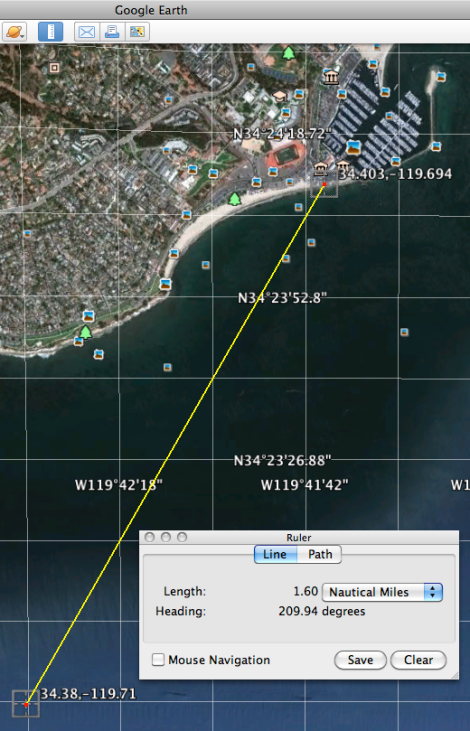
A recent trip to Santa Barbara, California, presented me with an opportunity to do some sights and calculations. In the following example I took a series of Sun sights in the morning and a single sight in the afternoon. The four morning sights were averaged to produce a single effective data point, whose LOP was then crossed with the LOP from the afternoon sight to obtain a fix.
Observation point:
Google Earth coordinates: Santa Barbara Sailing Club beach
N 34º 24.18′ i.e. 34.403
º
W 119º 41.64′ i.e. -119.694
º
These coordinates were used as the “assumed position” (AP) in the subsequent calculations of intercepts and azimuths.
Sun semidiameter (SD) = 15.7′
Sextant: Davis Mark 15
16 July 2011 (Sun: morning): T=25 ºC, P=1011 mb, Index Correction=+8.0′, Height of eye=6 ft
UT Hs Ho GHA Declination Intercept Azimuth
17:42:30 55° 48.2′ 56° 08.9′ 84° 06.4′ N 21° 19.9′ 0.4A 103.3
17:45:20 56° 23.4′ 56° 44.1′ 84° 48.9′ N 21° 19.8′ 0.8T 103.9
17:47:50 56° 51.6′ 57° 12.3′ 85° 26.4′ N 21° 19.8′ 1.0A 104.4
17:50:30 57° 22.4′ 57° 43.1′ 86° 06.4′ N 21° 19.8′ 2.1A 105.0
The spreadsheet average2.xls results in a simple average of these four observed altitudes:
that is:
UT Hs Ho GHA Declination Intercept Azimuth
17:46:32 — 56° 57.1′ 85° 06.9′ N 21° 19.8′ 0.6A 104.1
The single afternoon sight was (this time the sextant’s mirrors were adjusted to eliminate index error):
16 July 2011 (Sun: afternoon): T=26 ºC, P=1010 mb, Index Correction=0.0′, Height of eye=6 ft
UT Hs Ho GHA Declination Intercept Azimuth
21:18:20 69° 00.6′ 69° 13.6′ 138° 03.7′ N 21° 18.4′ 1.6T 235.8
The two LOP intersections can be computed either with spreadsheet lops.xls or two_body_fix.xls.
Solution #1 is relevant in our case:
N 34º 22.8′
W 119º 42.8′
This fix is only 1.7 nm bearing 215 from the Google Earth coordinates, as seen both from:
and a Google Earth measurement:

Overall I think I can be reasonably happy with these results and the intercepts I got. Considering the difficulties I had with the index error determination I was in fact a bit worried before I started the calculations. The error of fix and the standard deviation of intercepts are interestingly similar at about 2 nm. Using this value as the “Scatter” parameter in the weighted least-squares fitting procedure (average2.xls: fitted, not precomputed slope), all weights came out equal, so this procedure resulted in calculating the simple average of UT’s and Ho’s.
(first published on September 1, 2011)






